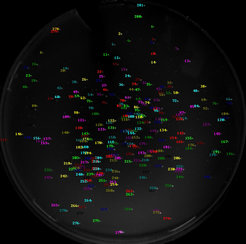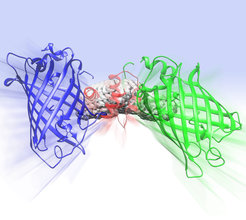New Lights for Research
New indicators create conditions for the observation of smallest biological processes
In 2008 the Nobel Prize was awarded for the discovery and development of the green fluorescent protein (GFP). Oliver Griesbeck, a former member of staff of one of the awardees and today research group leader at the Max Planck Institute of Neurobiology in Martinsried presents with an international team a new class of fluorescent indicator molecules. With these new indicators it is now possible to observe for example individual action potentials and thus the activity of nerve cells, or the movement of auto-aggressive immune cells, both in an unlimited period of time.
What is the migration route of nerve cells during development? How can auto-aggressive cells enter the brain? How are nerve cells connected in order to enable decision making or the formation of memory? The answers to these and numerous other questions are usually less than a few thousandths of a millimeter in size. Even under the best microscopes the movements or connections of singular cells remain invisible and hidden between countless other cells. That is the fact – unless the cells are brought out from the mass of cells.

Calcium indicators let cells glow
Researchers continue to develop new and increasingly effective fluorescent dyes in order to make the invisible visible. Action potentials of nerve cells or migrating cells can be revealed through minute variations in the cells’ internal calcium concentration. Calcium is found in every cell of the body and is generally bound. As soon as a cell becomes active, the cell’s internal concentration of free calcium temporarily increases. Dyes which bind calcium and show this bond by a change of color or intensity can thus make such cell processes visible. These so-called calcium indicators can be injected into cells and may highlight individual cells in a tissue, parts of cells, or specific cell processes under the microscope. For all their advantages, such dyes suffer from leakage and pale mostly after a short time, making long-term observations generally impossible.
An alternative to these synthetic calcium dyes are genetically encoded indicators. By inserting a gene into the genome of specific cells, these are able to produce the indicator on their own. The indicator is permanently reproduced and manipulations like the piercing of a cell to introduce the dye become unnecessary. Although these genetically coded indicator molecules are clearly better suited for experiments, they also have disadvantages: they are less sensitive and not compatible with all target cells.

Two sources for the best
Scientists from the Max Planck Institute of Neurobiology now present with an international team of colleagues the next generation of fluorescent dyes in the scientific journal Nature Methods. “We wanted to develop indicators which are as small as possible but still have all functional advantages”, relates Oliver Griesbeck, the head of the study. In order to achieve this aim the scientists designed 100,000 slightly different variations of the indicator gene and introduced them into bacteria colonies. Growing side by side, the different variations could then be directly compared under the fluorescent microscope. Only the best indicators were selected for the next round of development. Finally, after five years of intensive work, the researchers were content with their results and present the new "Twitch"-sensors.
“These indicators are better than anything else available”, enthuses Oliver Griesbeck. The indicators are smaller than all previous models - by considerably higher efficiency. Due to their small size they hardly compete with other cell processes for unbound calcium and have thus a negligible influence on such cell processes. Furthermore, the "Twitch"-sensors combine the advantages of the previous indicator types: They are comparable to synthetic indicators in their sensitivity and have the longevity of genetically coded dyes. Even immune cells, which always proved difficult, accept the new indicators without trouble. It is thus now possible to follow their activation and migration through the body under the microscope. “Now it doesn’t have to get any better”, rejoices Oliver Griesbeck. “From the side of the indicators, the investigation of aggressive immune cells and other body processes is no longer restricted.”







